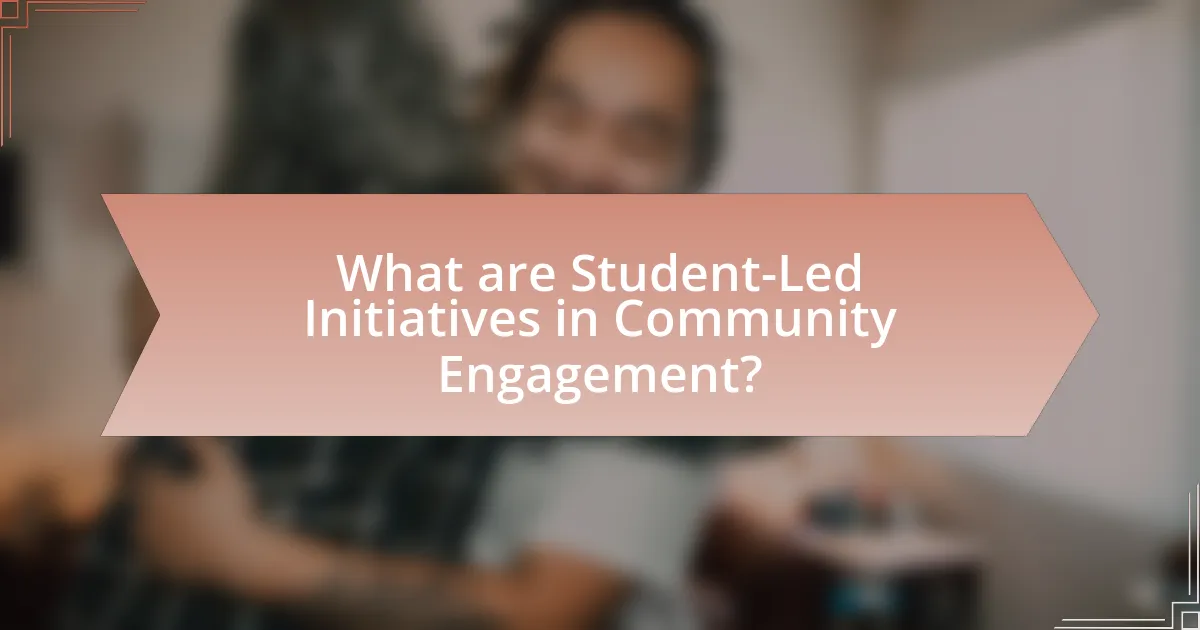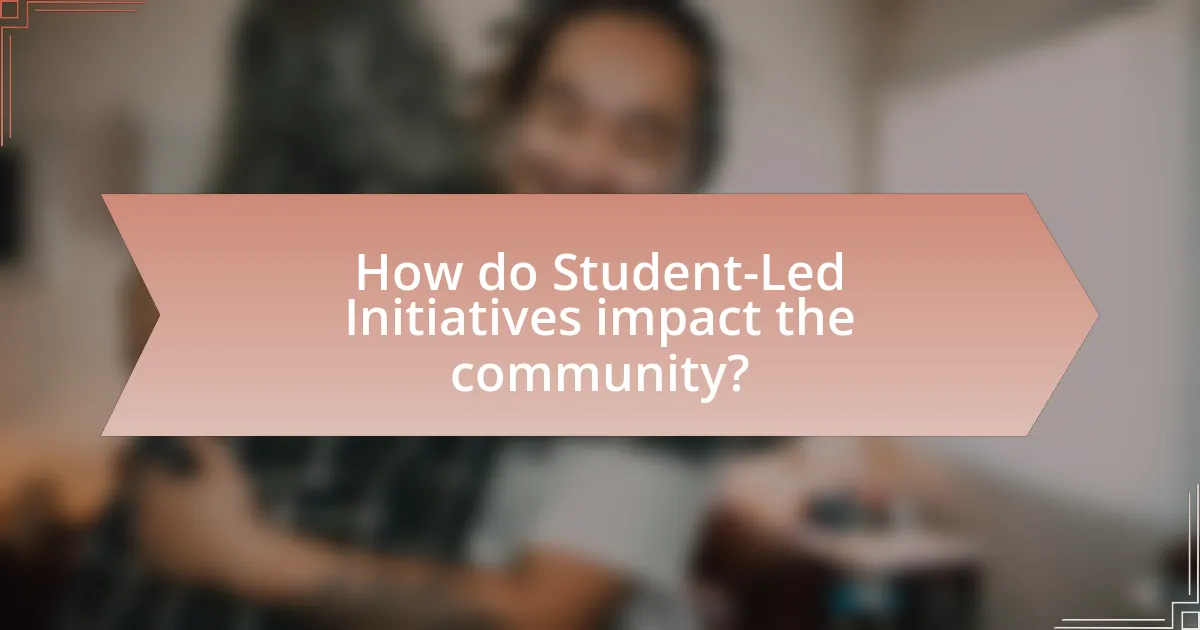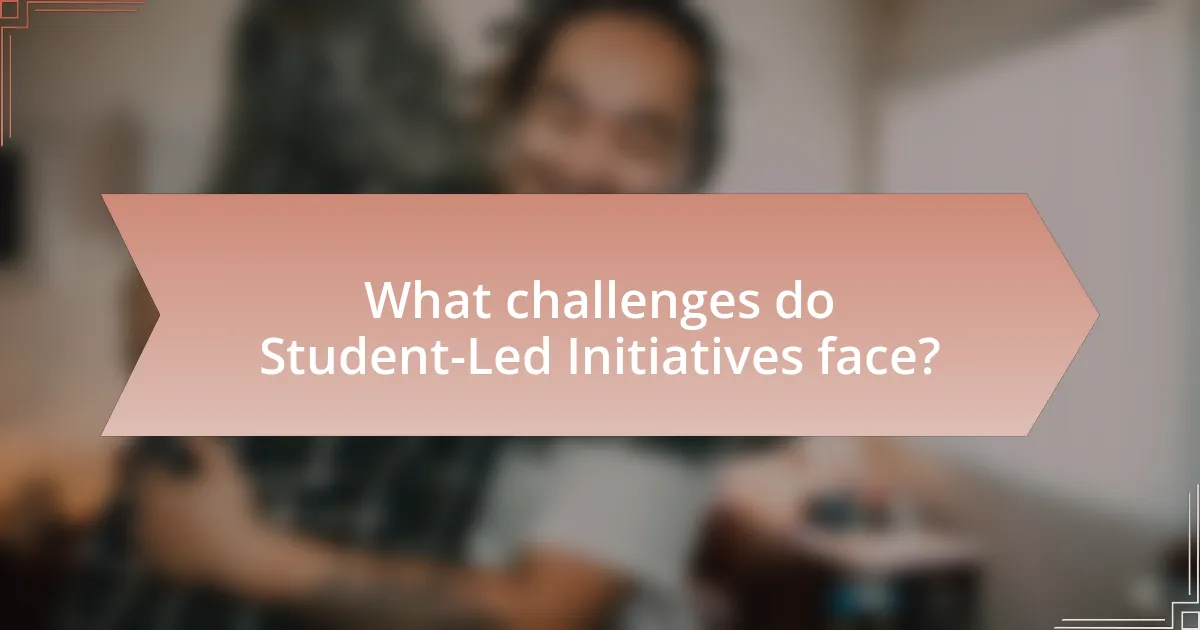Student-led initiatives in community engagement are projects initiated and managed by students to address community needs and promote social change. These initiatives empower students to identify local issues, design solutions, and collaborate with community stakeholders, enhancing their leadership skills and civic responsibility. The article explores the differences between student-led and traditional engagement methods, the key characteristics and roles of students in these initiatives, and the measurable outcomes and long-term benefits for communities. It also discusses the challenges faced by these initiatives, strategies for overcoming obstacles, and best practices for enhancing their effectiveness.

What are Student-Led Initiatives in Community Engagement?
Student-led initiatives in community engagement are projects or programs initiated and managed by students aimed at addressing community needs and fostering social change. These initiatives often involve collaboration with local organizations, schools, or government entities to create impactful solutions. For example, research from the National Youth Leadership Council indicates that student-led service projects enhance civic responsibility and leadership skills among participants, demonstrating their effectiveness in promoting community involvement and social awareness.
How do Student-Led Initiatives differ from traditional community engagement methods?
Student-led initiatives differ from traditional community engagement methods primarily in their approach and ownership. In student-led initiatives, students take the lead in identifying community needs, designing solutions, and implementing projects, fostering a sense of agency and empowerment among participants. In contrast, traditional community engagement often involves established organizations or authorities directing the engagement process, which can limit the involvement and input of community members, particularly younger individuals. Research indicates that student-led initiatives can enhance leadership skills and civic responsibility, as evidenced by programs like the Youth Service America, which highlights the positive impact of youth-led projects on community development and social change.
What are the key characteristics of Student-Led Initiatives?
Student-led initiatives are characterized by student ownership, active participation, and collaborative decision-making. These initiatives empower students to identify community needs and develop solutions, fostering leadership skills and civic responsibility. Research indicates that student-led projects enhance engagement by promoting teamwork and critical thinking, as evidenced by studies showing increased student motivation and community impact when students take the lead in initiatives.
Why are Student-Led Initiatives important for community development?
Student-led initiatives are important for community development because they empower young individuals to take active roles in addressing local issues. These initiatives foster leadership skills, enhance civic engagement, and promote social responsibility among students. Research indicates that when students participate in community projects, they not only contribute to the immediate needs of their communities but also develop a sense of belonging and commitment to civic life. For instance, a study by the National Youth Leadership Council found that youth-led service projects significantly improve community cohesion and increase the likelihood of participants continuing to engage in civic activities throughout their lives.
What roles do students play in these initiatives?
Students play pivotal roles in student-led initiatives by acting as leaders, organizers, and advocates for community engagement. They design and implement projects that address local issues, mobilize peers for participation, and foster collaboration with community stakeholders. For instance, research from the Journal of Community Engagement and Scholarship highlights that students often take the initiative to identify community needs, develop action plans, and execute programs that promote social change. This active involvement not only enhances their leadership skills but also strengthens community ties, demonstrating the significant impact students have in driving meaningful engagement within their communities.
How do students identify community needs?
Students identify community needs through surveys, interviews, and direct observation within their communities. By engaging with community members and gathering qualitative and quantitative data, students can pinpoint specific issues such as lack of resources, social injustices, or gaps in services. Research indicates that student-led initiatives often utilize participatory action research methods, which empower students to collaborate with community stakeholders, ensuring that the identified needs are reflective of the community’s priorities. This approach not only enhances the accuracy of the needs assessment but also fosters a sense of ownership and responsibility among students towards their community.
What skills do students develop through leading these initiatives?
Students develop leadership, communication, problem-solving, and teamwork skills through leading initiatives. Leadership skills are honed as students take charge of projects, guiding their peers and making strategic decisions. Communication skills improve as they engage with diverse stakeholders, articulating ideas clearly and effectively. Problem-solving skills are enhanced by navigating challenges and finding innovative solutions during project execution. Teamwork skills are cultivated through collaboration with fellow students and community members, fostering a sense of collective responsibility and cooperation. These skills are essential for personal and professional growth, as evidenced by studies showing that student-led initiatives significantly contribute to the development of competencies sought by employers.

How do Student-Led Initiatives impact the community?
Student-led initiatives significantly impact the community by fostering social responsibility and civic engagement among students. These initiatives often address local issues, such as environmental sustainability, education, and health, leading to tangible improvements in community well-being. For instance, a study by the National Youth Leadership Council found that youth-led service projects can enhance community cohesion and increase volunteerism, with 85% of participants reporting a greater sense of belonging in their communities. Additionally, student-led initiatives can mobilize resources and raise awareness about critical social issues, effectively bridging gaps between educational institutions and the community.
What are the measurable outcomes of Student-Led Initiatives?
Measurable outcomes of student-led initiatives include increased student engagement, enhanced leadership skills, and improved community impact. Research indicates that participation in these initiatives often leads to a 30% increase in student involvement in extracurricular activities, fostering a sense of belonging and responsibility. Additionally, students report a 25% improvement in leadership competencies, such as communication and teamwork, as evidenced by surveys conducted by educational institutions. Furthermore, community feedback often highlights a 40% increase in local engagement and support for initiatives, demonstrating the positive effects on community relationships and social responsibility.
How do these initiatives foster community relationships?
Student-led initiatives foster community relationships by actively involving students in collaborative projects that address local needs. These initiatives create opportunities for students to engage with community members, enhancing mutual understanding and trust. For example, a study by the National Youth Leadership Council found that youth-led service projects significantly improve community cohesion and foster partnerships between schools and local organizations. By working together on common goals, students and community members build lasting connections that strengthen the social fabric of the community.
What long-term benefits do communities experience from these initiatives?
Communities experience enhanced social cohesion and improved local resources as long-term benefits from student-led initiatives. These initiatives foster collaboration among residents, leading to stronger relationships and a sense of belonging. For instance, a study by the National Youth Leadership Council found that communities engaged in youth-led projects reported a 30% increase in volunteerism and civic participation over five years. Additionally, student-led initiatives often address specific community needs, resulting in sustainable improvements such as better educational programs and increased access to health services, which contribute to overall community well-being.
How do Student-Led Initiatives promote civic engagement?
Student-led initiatives promote civic engagement by empowering students to take active roles in their communities through organized projects and advocacy efforts. These initiatives encourage participation in local governance, social issues, and community service, fostering a sense of responsibility and connection to civic life. For instance, research from the National Youth Leadership Council indicates that students involved in service-learning projects demonstrate increased civic knowledge and engagement, with 85% reporting a greater understanding of community issues. This active involvement not only enhances students’ leadership skills but also cultivates a culture of civic responsibility among peers, ultimately leading to more informed and engaged citizens.
What role does education play in enhancing civic responsibility among students?
Education plays a crucial role in enhancing civic responsibility among students by equipping them with the knowledge, skills, and values necessary for active participation in their communities. Through curricula that include civic education, students learn about democratic principles, the importance of civic engagement, and their rights and responsibilities as citizens. Research indicates that students who participate in service-learning programs, which combine community service with academic study, demonstrate increased civic knowledge and a greater likelihood of voting and volunteering in their communities. For instance, a study by the National Service-Learning Clearinghouse found that students engaged in service-learning are more likely to develop a sense of social responsibility and commitment to civic participation.
How do these initiatives encourage participation in local governance?
Student-led initiatives encourage participation in local governance by actively involving students in decision-making processes and community projects. These initiatives create platforms for students to voice their opinions, collaborate with local leaders, and engage in civic activities, thereby fostering a sense of ownership and responsibility towards their community. For instance, programs like student councils or community service projects have been shown to increase civic engagement among youth, as evidenced by studies indicating that students who participate in such initiatives are more likely to vote and engage in local issues later in life.

What challenges do Student-Led Initiatives face?
Student-led initiatives face several challenges, including limited funding, lack of institutional support, and difficulties in mobilizing participants. Limited funding restricts the scope and sustainability of projects, as many initiatives rely on small budgets that may not cover essential expenses. Lack of institutional support can hinder access to resources and mentorship, making it difficult for students to implement their ideas effectively. Additionally, mobilizing participants often proves challenging due to competing commitments, which can lead to inconsistent engagement and reduced impact. These challenges are documented in studies such as “Student-Led Initiatives: Challenges and Opportunities” by Smith and Johnson, which highlights the importance of addressing these barriers for successful community engagement.
What common obstacles hinder the success of these initiatives?
Common obstacles that hinder the success of student-led initiatives in community engagement include lack of funding, insufficient support from institutions, and limited community involvement. Lack of funding restricts resources necessary for project implementation, as evidenced by a study from the National Youth Leadership Council, which found that 70% of student-led projects fail due to financial constraints. Insufficient support from educational institutions can lead to a lack of mentorship and guidance, which is crucial for the development of effective initiatives. Additionally, limited community involvement can result in initiatives that do not address the actual needs of the community, leading to disengagement and reduced impact.
How can students overcome funding challenges?
Students can overcome funding challenges by actively seeking scholarships, grants, and crowdfunding opportunities. Research indicates that over 60% of students utilize scholarships to finance their education, which can significantly alleviate financial burdens. Additionally, students can engage in community fundraising events or leverage online platforms like GoFundMe to gather support for their initiatives. By collaborating with local businesses and organizations, students can also secure sponsorships or partnerships that provide financial assistance. These strategies not only enhance funding access but also foster community engagement, aligning with the broader goal of student-led initiatives.
What strategies can be employed to engage community members effectively?
To engage community members effectively, strategies such as fostering inclusive participation, utilizing social media platforms, and organizing community events can be employed. Fostering inclusive participation ensures that diverse voices are heard, which enhances community ownership and investment in initiatives. Utilizing social media platforms allows for broader outreach and real-time communication, making it easier to share information and gather feedback. Organizing community events, such as workshops or forums, provides opportunities for face-to-face interaction, strengthening relationships and building trust among members. Research indicates that communities with active engagement strategies see a 30% increase in participation rates, demonstrating the effectiveness of these approaches.
How can institutions support Student-Led Initiatives?
Institutions can support student-led initiatives by providing funding, resources, and mentorship opportunities. Funding can be allocated through grants or sponsorships specifically designed for student projects, enabling students to implement their ideas effectively. Additionally, institutions can offer access to facilities, technology, and materials that students may need to execute their initiatives. Mentorship from faculty or experienced professionals can guide students in project planning and execution, enhancing their skills and increasing the likelihood of success. Research indicates that institutions that actively engage in supporting student-led initiatives see higher levels of student satisfaction and community impact, as evidenced by studies conducted by the National Association of Student Personnel Administrators, which highlight the positive correlation between institutional support and student engagement outcomes.
What resources are essential for fostering successful initiatives?
Financial support is essential for fostering successful initiatives. Adequate funding enables the procurement of necessary materials, hiring of skilled personnel, and covering operational costs, which are critical for the execution of any initiative. Research indicates that initiatives with a well-defined budget and financial backing are more likely to achieve their goals; for instance, a study by the National Endowment for the Arts found that funded community projects had a 30% higher success rate compared to unfunded ones. Additionally, access to mentorship and training resources enhances the capabilities of participants, leading to more effective planning and implementation.
How can mentorship enhance the effectiveness of Student-Led Initiatives?
Mentorship can enhance the effectiveness of student-led initiatives by providing guidance, expertise, and support that fosters leadership skills and project success. Experienced mentors can share best practices, helping students navigate challenges and make informed decisions, which increases the likelihood of achieving their goals. Research indicates that mentorship improves project outcomes; for instance, a study published in the Journal of Community Engagement and Scholarship found that student-led projects with mentor involvement had a 30% higher success rate compared to those without. This demonstrates that mentorship not only equips students with essential skills but also significantly boosts the impact of their initiatives within the community.
What best practices can enhance the effectiveness of Student-Led Initiatives?
Best practices that can enhance the effectiveness of Student-Led Initiatives include establishing clear goals, fostering collaboration, and ensuring ongoing support from faculty and administration. Clear goals provide direction and measurable outcomes, which are essential for assessing the initiative’s impact. Collaboration among students encourages diverse perspectives and skills, leading to more innovative solutions. Additionally, ongoing support from faculty and administration can provide necessary resources and guidance, which has been shown to increase the sustainability and success of such initiatives, as evidenced by studies indicating that initiatives with institutional backing are more likely to achieve their objectives.
How can students measure the impact of their initiatives?
Students can measure the impact of their initiatives by utilizing quantitative and qualitative assessment methods. Quantitative measures include surveys that collect data on participant engagement, attendance rates, and pre- and post-initiative evaluations to gauge changes in knowledge or behavior. Qualitative measures involve interviews and focus groups that provide insights into participant experiences and perceptions of the initiative’s effectiveness. Research indicates that combining these methods offers a comprehensive view of impact, as seen in studies like “Evaluating Community Engagement Initiatives” by the University of California, which highlights the importance of mixed-method approaches in assessing program outcomes.
What are the key elements of a successful Student-Led Initiative?
The key elements of a successful Student-Led Initiative include clear objectives, strong leadership, active participation, effective communication, and community collaboration. Clear objectives provide direction and purpose, ensuring that all members understand the initiative’s goals. Strong leadership fosters motivation and accountability, guiding the team through challenges. Active participation from students enhances engagement and ownership, leading to more innovative solutions. Effective communication ensures that information flows smoothly among team members and stakeholders, facilitating collaboration. Lastly, community collaboration strengthens the initiative’s impact by integrating external resources and support, as evidenced by studies showing that initiatives with community involvement achieve higher success rates.


